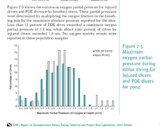I really sympathize with the question. I, too, would love to see some good data. The main trouble is that scientists really don't have a good understanding of the mechanisms that cause ox tox. That makes it harder to model it, but even so, the rules of thumb we are given in training aren't that good. All that time we used to spend calculating CNS% and OTUs to be told they're very poor guides indeed - though better than nothing. At least, they make you aware of the problem and monitor your dose. Given the huge variations between people, and the large variations from the same person day to day it's impossible to be sure how much risk you're really taking on, though. The more you push the limits the more you realize how fuzzy those limits are.
Go to 'oxygen toxicity' on Wikipedia, then follow the links at the bottom: there are some great links there.
Go to 'oxygen toxicity' on Wikipedia, then follow the links at the bottom: there are some great links there.




